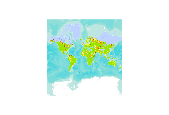Filters
Date Range
Contacts
Tag Schemes
|

Nutrient retention capacity is of particular importance for the effectiveness of fertilizer applications and is therefore of special relevance for intermediate and high input level cropping conditions. Nutrient retention capacity refers to the capacity of the soil to retain added nutrients against losses caused by leaching. Plant nutrients are held in the soil on the exchange sites provided by the clay fraction, organic matter and the clay-humus complex. Losses vary with the intensity of leaching which is determined by the rate of drainage of soil moisture through the soil profile. Soil texture affects nutrient retention capacity in two ways, through its effects on available exchange sites on the clay minerals and...

This soil quality is decisive for successful low level input farming and to some extent also for intermediate input levels. Diagnostics related to nutrient availability are manifold. Important soil characteristics of the topsoil (0-30 cm) are: Texture/Structure, Organic Carbon (OC), pH and Total Exchangeable Bases (TEB). For the subsoil (30-100 cm), the most important characteristics considered are: Texture/Structure, pH and TEB. The soil characteristics relevant to soil nutrient availability are to some extent correlated. For this reason, the most limiting soil characteristic is combined in the evaluation with the average of the remaining less limiting soil characteristics to represent soil quality SQ1. Soil...

Diagnostic characteristics to indicate soil workability vary by type of management applied. Workability or ease of tillage depends on interrelated soil characteristics such as texture, structure, organic matter content, soil consistence/bulk density, the occurrence of gravel or stones in the profile or at the soil surface, and the presence of continuous hard rock at shallow depth as well as rock outcrops. Some soils are easy to work independent of moisture conditions, other soils are only manageable at an adequate moisture status, in particular for manual cultivation or light machinery. Irregular soil depth, gravel and stones in the profile and rock outcrops, might prevent the use of heavy farm machinery. The soil...

Diagnostic characteristics to indicate soil workability vary by type of management applied. Workability or ease of tillage depends on interrelated soil characteristics such as texture, structure, organic matter content, soil consistence/bulk density, the occurrence of gravel or stones in the profile or at the soil surface, and the presence of continuous hard rock at shallow depth as well as rock outcrops. Some soils are easy to work independent of moisture conditions, other soils are only manageable at an adequate moisture status, in particular for manual cultivation or light machinery. Irregular soil depth, gravel and stones in the profile and rock outcrops, might prevent the use of heavy farm machinery. The soil...

Oxygen availability in soils is largely defined by drainage characteristics of soils. The determination of soil drainage classes is based on procedures developed at FAO (FAO 1995). These procedures take into account soil type, soil texture, soil phases and terrain slope. Apart from drainage characteristics, the soil quality of oxygen availability may be influenced by soil and terrain characteristics that are defined through the occurrence of specific soil phases. These include for the FAO 74 classification soil phases indicating phreatic conditions, and for the FAO 90 classification soil phases indicating respectively phreatic, anthraquic, inundic, or placic conditions. Soil qualities have been estimated for...

Low pH leads to acidity related toxicities, e.g., aluminum, iron, manganese toxicities, and to various deficiencies, e.g., of phosphorus and molybdenum. Calcareous soils exhibit generally micronutrient deficiencies, for instance of iron, manganese, and zinc and in some cases toxicity of molybdenum. Gypsum strongly limits available soil moisture. Tolerance of crops to calcium carbonate and gypsum varies widely (FAO, 1990; Sys, 1993). Low pH and high calcium carbonate and gypsum are mutually exclusive. Acidity related toxicities such as aluminum toxicities and micro-nutrient deficiencies are accounted for respectively in SQ1, nutrient availability, and in SQ2, nutrient retention capacity. This soil quality SQ6 is...

Accumulation of salts may cause salinity. Excess of free salts referred to as soil salinity is measured as Electric Conductivity (EC in dS/m) or as saturation of the exchange complex with sodium ions, which is referred to as sodicity or sodium alkalinity and is measured as Exchangeable Sodium Percentage (ESP). Salinity affects crops through inhibiting the uptake of water. Moderate salinity affects growth and reduces yields; high salinity levels may kill the crop. Sodicity causes sodium toxicity and affects soil structure leading to massive or coarse columnar structure with low permeability. Apart from soil salinity and sodicity, conditions indicated by saline (salic) and sodic soil phases may affect crop growth...
|
|